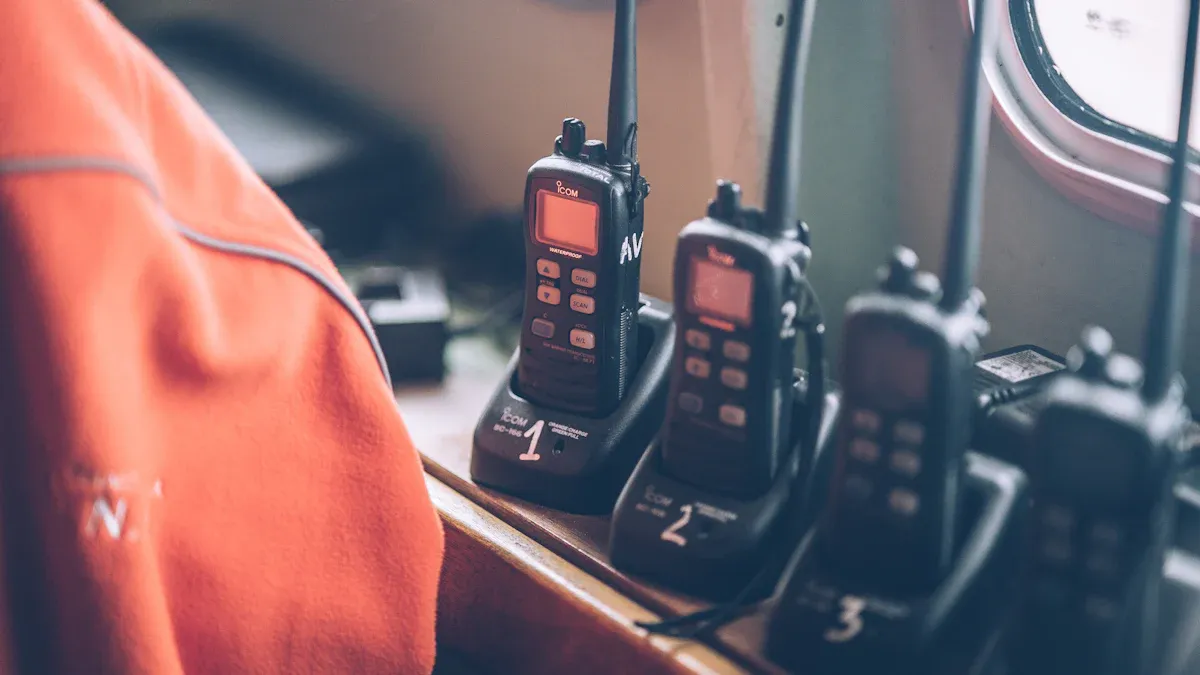
Push to talk telephone handsets enable instant communication with just the press of a button. These telephone handsets are crafted for quick and dependable communication across different environments. Whether you rely on a fireman telephone handset in emergency situations or a public telephone handset in bustling areas, their effectiveness makes them essential tools for numerous industries. Additionally, the plastic telephone handset offers durability and ease of use, further enhancing the communication experience.
Key Takeaways
- Push-to-talk phones let you talk fast by pressing a button.
- They block background noise, so voices stay clear in noisy places.
- These phones are tough and work well in rough conditions, great for many jobs.
Understanding Push to Talk Telephone Handsets
Definition and Key Features
A push to talk telephone handset is a communication device that allows you to connect with others instantly by pressing a button. Unlike traditional telephones, these handsets operate on a half-duplex communication system. This means only one person can speak at a time, ensuring clear and uninterrupted conversations.
Key features of these handsets include:
- Push-to-Talk Button: This button activates the microphone, letting you speak instantly.
- Durable Design: Many models are built to withstand harsh environments, making them ideal for industries like construction or emergency services.
- Noise-Canceling Technology: This feature ensures your voice remains clear, even in noisy surroundings.
- Group Communication: Some handsets allow you to connect with multiple users at once, improving team coordination.
These features make push to talk telephone handsets a reliable choice for quick and efficient communication.
How They Differ from Traditional Telephones
Push to talk telephone handsets differ from traditional telephones in several ways. Traditional phones rely on full-duplex communication, where both parties can speak and listen simultaneously. In contrast, push-to-talk systems use a half-duplex mode, which prioritizes clarity over simultaneous interaction.
Another key difference lies in their purpose. Traditional telephones are designed for general use, such as personal or business calls. Push to talk telephone handsets, however, are tailored for specific scenarios where instant communication is crucial. For example, they are commonly used in industries like transportation, public safety, and event management.
Additionally, these handsets often feature rugged designs and advanced technologies like noise cancellation, which are not typically found in standard telephones. This makes them more suitable for challenging environments where reliability is essential.
Tip: If you need a device for quick, clear, and dependable communication, a push to talk telephone handset might be the perfect solution for your needs.
How Push to Talk Telephone Handsets Work

The Push-to-Talk Mechanism
The push-to-talk mechanism is simple yet effective. When you press the designated button on a Push to Talk Telephone Handset, the microphone activates, allowing you to speak. Releasing the button ends your turn and lets others respond. This system ensures clear communication by allowing only one person to talk at a time. It eliminates the confusion of overlapping voices, which often happens in traditional phone calls.
This mechanism works well in situations where quick and direct communication is essential. For example, emergency responders use it to coordinate actions during critical moments. The push-to-talk button acts as a gatekeeper, ensuring that messages are delivered without interruptions.
Core Technologies and Systems
Push-to-talk handsets rely on advanced technologies to function. Many systems use radio frequencies to transmit voice signals over short or long distances. Some modern devices also operate on cellular networks or Wi-Fi, enabling communication across vast areas.
These handsets often include features like noise-canceling microphones and high-quality speakers. These technologies ensure that your voice remains clear, even in noisy environments. Additionally, group communication systems allow multiple users to connect simultaneously, making teamwork more efficient.
Analog vs. Digital Push-to-Talk Systems
Push-to-talk systems come in two main types: analog and digital. Analog systems are older and use continuous signals to transmit voice. They are reliable but may lack the clarity and advanced features of digital systems.
Digital push-to-talk systems, on the other hand, convert voice into data packets. This method provides better sound quality and supports additional features like encryption for secure communication. Digital systems are more common today due to their versatility and ability to integrate with modern technologies.
Note: Choosing between analog and digital depends on your specific needs. Analog systems are cost-effective, while digital systems offer advanced capabilities.
Applications of Push to Talk Telephone Handsets

Industries That Benefit from Push-to-Talk
Push-to-talk technology plays a vital role in industries where fast and reliable communication is essential. Emergency services, such as police, firefighters, and paramedics, rely on these devices to coordinate responses during critical situations. Construction teams also benefit from push-to-talk systems. Workers can communicate instantly across large sites, improving safety and efficiency.
In the transportation sector, drivers and dispatchers use push-to-talk devices to stay connected. This ensures smooth operations and quick problem-solving. Event management teams also depend on these handsets to coordinate staff during large gatherings. Whether it’s a concert or a sports event, instant communication helps everything run smoothly.
Everyday Scenarios for Push-to-Talk Use
Push-to-talk devices are not just for professionals. They can also simplify communication in everyday situations. Families on road trips can use them to stay connected between vehicles. Outdoor enthusiasts, like hikers or campers, find them useful in areas with no cell service.
Push-to-talk systems are also great for schools. Teachers and staff can use them to communicate during emergencies or daily operations. Even small businesses, such as restaurants or retail stores, benefit from these devices. They allow employees to coordinate tasks quickly, enhancing customer service.
A Push to Talk Telephone Handset offers a practical solution for anyone needing instant, clear communication. Its versatility makes it valuable in both professional and personal settings.
Benefits of Push to Talk Telephone Handsets
Instant and Efficient Communication
A Push to Talk Telephone Handset allows you to communicate instantly with just the press of a button. This feature eliminates the need to dial numbers or wait for someone to pick up. You can deliver your message quickly, which is especially useful in time-sensitive situations. For example, emergency responders use these devices to share critical updates without delay.
This instant communication also improves teamwork. When you need to coordinate with a group, everyone can stay on the same page. Whether you’re managing a construction site or organizing an event, this efficiency saves time and reduces misunderstandings.
Tip: Use push-to-talk devices when you need fast and clear communication to keep your team connected and productive.
Noise-Canceling Features
Push-to-talk handsets often include noise-canceling technology. This feature ensures your voice remains clear, even in noisy environments. Imagine working on a busy construction site or in a crowded event space. Background noise can make it hard to hear or be heard. Noise-canceling microphones filter out these distractions, so your message gets through without interference.
This technology is not just for professionals. If you’re hiking in windy conditions or driving with the windows down, a Push to Talk Telephone Handset with noise-canceling features can make communication much easier. Clear audio improves safety and ensures that important information is never missed.
Cost-Effectiveness and Reliability
Push-to-talk devices are a cost-effective solution for communication. Unlike traditional phones, they don’t require expensive monthly plans. Many models operate on radio frequencies, which means you can use them without worrying about additional charges. Even those that rely on cellular networks often come with affordable plans tailored to specific needs.
Reliability is another key benefit. These handsets are designed to work in challenging conditions where other devices might fail. For instance, they can maintain a connection in remote areas with no cell service. This makes them a dependable choice for industries like transportation, emergency services, and outdoor recreation.
Note: If you’re looking for a budget-friendly and reliable communication tool, a push-to-talk handset is worth considering.
Durability in Challenging Environments
Push-to-talk handsets are built to last. Many models feature rugged designs that can withstand harsh conditions. Whether you’re working in extreme temperatures, dusty environments, or wet conditions, these devices keep functioning. This durability makes them ideal for industries like construction, mining, and public safety.
Even in everyday use, their sturdy construction ensures they can handle accidental drops or rough handling. If you’re an outdoor enthusiast, you can rely on these handsets during camping trips or hikes. Their robust design ensures they won’t let you down when you need them most.
Reminder: Choose a Push to Talk Telephone Handset with a durable design if you work in tough environments or enjoy outdoor adventures.
Push-to-talk telephone handsets offer instant communication with a simple button press. You’ve learned how they work, their unique features, and the benefits they bring, such as durability and cost-effectiveness.
These devices improve communication and efficiency in industries like public safety, construction, and transportation.
Explore push-to-talk handsets to find the perfect solution for your communication needs.
FAQ
What is the range of a push-to-talk telephone handset?
The range depends on the model. Some devices work within a few miles, while others, using cellular or Wi-Fi networks, can cover much larger areas.
Can push-to-talk handsets work without internet or cellular service?
Yes, many models use radio frequencies. These devices operate independently of internet or cellular networks, making them reliable in remote areas or during emergencies.
Are push-to-talk handsets difficult to use?
Not at all! These devices are user-friendly. You press a button to talk and release it to listen. Their simplicity makes them ideal for all users.
Tip: Practice using the push-to-talk button to get comfortable with the device quickly.


